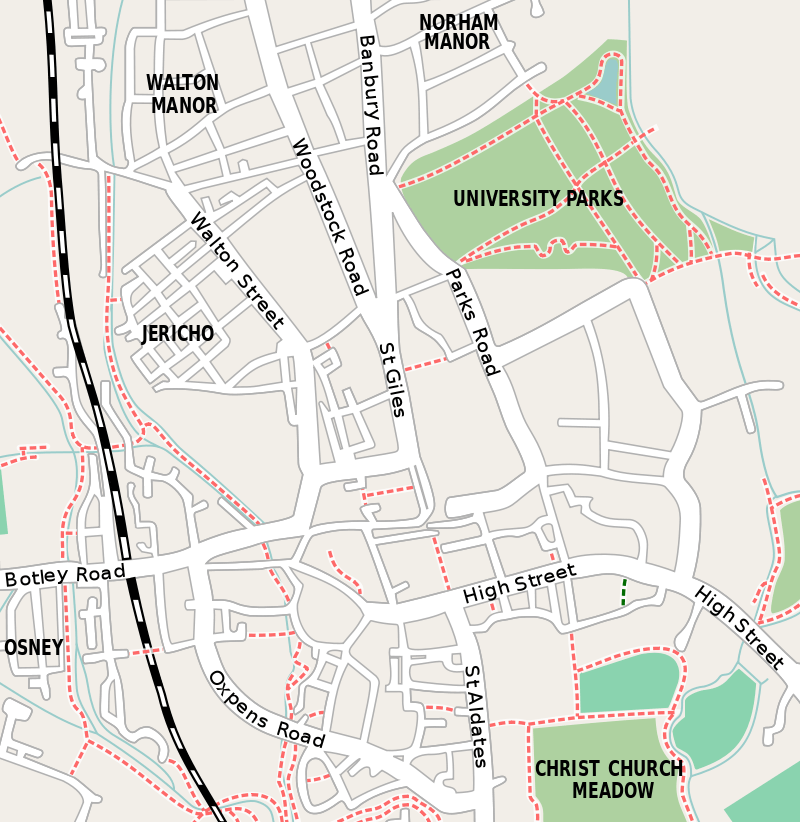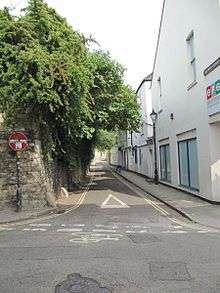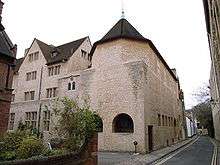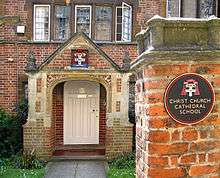Brewer Street, Oxford
Brewer Street is a historic narrow street in central Oxford, England, south of Carfax.[1] The street runs east-west, connecting with St Aldate's to the east and St Ebbe's Street to the west.
 Location of Brewer Street in central Oxford. | |
|---|---|
 Brewer Street with Pembroke College on the left, from St Ebbe's Street | |
| Former name(s) | Sleyng Lane Sleyne Lane Slaying Lane Slaughter Lane Brewers Street |
| Length | 540 ft (160 m) |
| Postal code | OX1 1 |
| east end | St Aldate's |
| west end | St Ebbe's Street |
History
Originally, the area was occupied by butchers and slaughters, giving it the name Sleyng Lane (in 1478).[2] The lane became known as Sleyne Lane (in 1690), Slaying Lane (in 1811), Slaughter Lane (in 1840). In 1772, it became Brewer Street and Lane. In 1932, the street was marked with a sign of "Brewers Street" at the St Aldate's end and "Brewer Street" at the St Ebbe's end. The latter was adopted on 14 January 1932. The current street name derives from a brewhouse in the location, dating from the 17th century.
Institutions
Campion Hall, a Permanent Private Hall of the University of Oxford, is on the south side.[3] The hall is run by the Society of Jesus. It is the only building in Oxford designed by Sir Edwin Lutyens and was opened in 1936.[4] The building was Grade II* listed in 2000.[5] Rose Place is further to the south.
Christ Church Cathedral School, associated with Christ Church Cathedral and College close to the school on the other side of St Aldate's, is located at 3 Brewer Street. The school educates the choristers for the cathedral and college. The house of Cardinal Wolsey, the founder of the college, is still used for teaching.[6]
Pembroke College, one of the colleges of Oxford University, is on the north side of the street, with its main entrance in Pembroke Square. Part of the city wall is preserved in the exterior wall of Pembroke College on Brewer Street. Other parts can be found in the gardens of New College and Merton College. In 2010, Pembroke College began a major new development south of the main site, to which it is linked by a bridge over Brewer Street. The new buildings were expected to be completed in 2012.[7]
Famous people
The author Dorothy L. Sayers (1893–1957) was born at 1 Brewer Street on 13 June 1893.[8] The house is marked with a blue plaque.
Gallery
 View of Campion Hall, including the chapel, on the south side of Brewer Street.
View of Campion Hall, including the chapel, on the south side of Brewer Street. Doorway of Campion Hall on Brewer Street.
Doorway of Campion Hall on Brewer Street. Christ Church Cathedral School at 3 Brewer Street.
Christ Church Cathedral School at 3 Brewer Street.
References
- Sherwood, Jennifer; Pevsner, Nikolaus (1974). The Buildings of England: Oxfordshire. Penguin Books. pp. 34, 182, 184, 224, 301, 326. ISBN 0-14-071045-0.
- Symonds, Ann Spokes; Morgan, Nigel (2011). The Origins of Oxford Street Names. Witney, Oxfordshire: Robert Boyd Publications. p. 79. ISBN 978 1 899536 99 3.
- Tyack, Geoffrey (1998). Oxford: An architectural guide. Oxford University Press. pp. 286–287. ISBN 0-14-071045-0.
- Brown, Jane (1996). Lutyens and the Edwardians: An English Architect and his Clients. London: Viking. pp. 223–227. ISBN 0-670-85871-4.
- Historic England. "Details from listed building database (1046738)". National Heritage List for England. Retrieved 7 June 2011.
- "Christ Church Cathedral School". BoardingSchools.co.uk. Archived from the original on 10 September 2011. Retrieved 7 June 2011.
- "Pembroke College, Oxford to expand significantly". News releases for journalists. University of Oxford, UK. 2 November 2010. Archived from the original on 28 July 2011. Retrieved 7 June 2011.
- Warr, Elizabeth Jean (2011). The Oxford Plaque Guide. Stroud, Gloucestershire: The History Press. pp. 113–114. ISBN 978-0-7524-5687-4.